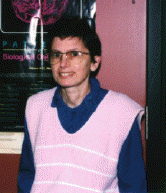


Piroska Huvos received her B.S. degree and her Ph.D. degree from the Eotvos Lorand University, Budapest (1969). She joined SIUC as an Adjunct Faculty in 1988.
phone: (618) 453-6469
email: phuvos@siumed.edu
Programmed genome rearrangements can be an essential part of normal development in organisms ranging from bacteria to mammals. Genome rearrangements are also associated with certain diseases, such as cancer, and contribute to the remodeling of the genome during evolution. Ciliated protozoans are used as a model system for the study of DNA rearrangements, as they undergo extensive programmed genome rearrangements during development of a somatic macronucleus from a germline micronucleus.
In Tetrahymena thermophila, short segments of developmentally eliminated DNA are dispersed at thousands of sites in the genome. A few of these rearrangement sites have been studied in detail, however, almost no common features are detectable among the eliminated segments or among the immediately flanking retained sequences.
The major ongoing effort in my laboratory is directed towards comparing some of these rearrangement sites in several species to identify: A) sequences changes that allow the developmental rearrangements to remain functional, and B) sequence changes that lead to the generation or disappearance of rearrangements during evolution.
The main techniques used are sequence analysis of amplified or cloned DNA. The main objective is to examine the relationship between programmed (developmental) and unprogrammed (evolutionary) changes occurring at the rearrangements sites.
Another interest is to use whole genome analysis utilizing repeated probes. This versatile technique is explored using the Tetrahymena genome but it is applicable to other genomes for the analysis of genomic changes occurring under different conditions.
Huvos, P. 2007. Extensive changes in the locations and sequence content of developmentally deleted DNA between Tetrahymena thermophila and its closest relative, T. malaccensis. J Eukaryot Microbiol. 54:73-82.
Huvos, P. 2004. Modular structure of developmentally eliminated DNA in Tetrahymena may be a consequence of frequent insertions and deletions. J. Mol. Biol. 336:1075-1086.
Huvos, P. 2004. A member of a repeat family is the source of an insertion-deletion polymorphism inside a developmentally eliminated sequence of Tetrahymena thermophila. J. Mol. Biol. 336:1061-1073.
Huvos, P., M. Wu, and M. A. Gorovsky. 1998. A developmentally eliminated sequence in the flanking region of the histone H1 gene in Tetrahymena thermophila contains short repeats. J. Eucaryotic Microbiology 45:189-197.
Shi, X., M. Chen, P. E. Huvos, and P. M. D. Hardwicke. 1998. Amino acid sequence of a Ca2+-transporting ATPase from the sarcoplamsic reticulum of the cross-striated part of the adductor muscle of the deep sea scallop. Comparision to SERCA enzymes of other animals. Comparative Biochemistry and Physiology Part B 120:359-374.
Huvos, P. 1995. Developmental rearrangements and micronucleus-specific sequences in the Tetrahymena pyriformis species complex. Genetics 141:925-936.
Hardwicke, P.M.D. and P. Huvos. 1989. Effect of K+, and other ligands on the thiol reactivity and tryptic cleavage pattern of scallop sarcoplasmic reticulum. J. Muscle Res. Cell Motility 10:239-244.
Hüvos, P.E., J. A. Sanchez, K. M. Kramer, K. M. Karrer, and L. J. Wangh. 1988. Two-dimensional DNA gel electrophoresis as a method for analysis of eucaryotic genome structure: evaluation using Tetrahymena thermophila DNA. Biochim. Biophys. Acta 949:325-333.
![]() Biochemistry and Molecular
Biology Home Page
Biochemistry and Molecular
Biology Home Page